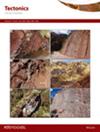A Complex Interplay Between Pluton Emplacement, Tectonic Deformation, and Plate Kinematics in the Cretaceous Sierra Nevada Magmatic Arc, California
IF 3.6
1区 地球科学
Q1 GEOCHEMISTRY & GEOPHYSICS
引用次数: 0
Abstract
The relation of plate kinematics to the structural record of arc plutons and their host rocks is complex and still not fully understood. We address this issue through a combination of field mapping, structural analysis, anisotropy of magnetic susceptibility analysis, and fabric modeling in the Late Cretaceous Tuolumne Intrusive Complex, Sierra Nevada, California. A pattern of anti-clockwise rotation from ∼NNW–SSE to WNW–ESE steep foliations and change in fabric ellipsoid shape from oblate to prolate was revealed in successively emplaced Kuna Crest (∼95–92 Ma), Half Dome (∼92–89 Ma), and Cathedral Peak (∼89–84 Ma) granodiorites. The numerical model indicates that the Kuna Crest was emplaced in a transpressional setting with an angle of convergence α = 60–40°, whereas the Half Dome and Cathedral Peak required simultaneous vertical constriction overprinted by transpression with α = 35–15°. This transition, which occurred at ∼92 Ma, is accompanied by a shallowing of the lineation plunge observed also in other ∼88–84 Ma central Sierra Nevada plutons. Provided that the Cretaceous Sierra Nevada arc was constructed during overall dextral transpression, these transitions reflect significant changes in kinematics, where ∼107–92 Ma plutons were emplaced during pure shear-dominated transpression, which was followed by a transition to wrench-dominated transpression recorded in ∼92–84 Ma plutons. Such a transition in kinematics is explained as a result of progressively increasing obliquity of the relative convergence of the Farallon plate subducting beneath the North American continental margin, in agreement with most paleogeographic reconstructions.加利福尼亚州白垩纪内华达山脉岩浆弧区的岩浆置换、构造变形和板块运动学之间的复杂相互作用
板块运动学与弧形柱岩及其母岩的结构记录之间的关系非常复杂,至今仍未完全搞清楚。我们在加利福尼亚州内华达山脉的晚白垩世图奥卢姆内侵入复合体(Tuolumne Intrusive Complex)中,通过实地测绘、结构分析、磁感应强度各向异性分析和构造建模相结合的方法来解决这个问题。在相继出露的 Kuna Crest(95-92 Ma)、Half Dome(92-89 Ma)和 Cathedral Peak(89-84 Ma)花岗闪长岩中,发现了从∼NNW-SSE 到 WNW-ESE 陡峭褶皱的逆时针旋转模式,以及构造椭球体形状从扁球形到长球形的变化。数值模型表明,库纳峰丛是在换位环境中堆积的,其汇聚角α=60-40°,而半圆顶和大教堂峰丛则需要同时进行垂直收缩,并叠加换位作用,其汇聚角α=35-15°。这一转变发生在 ∼92 Ma,与此同时,在其他 ∼88-84 Ma 的内华达山脉中部岩浆岩中也观察到了线状暴跌的变浅。如果白垩纪内华达山脉弧是在整体右旋转位过程中形成的,那么这些转变反映了运动学的重大变化,即 107-92 Ma ∼的岩柱是在纯剪切主导的转位过程中喷出的,而在 92-84 Ma ∼的岩柱中则过渡到了扳动主导的转位。这种运动学上的过渡可解释为俯冲于北美大陆边缘之下的法拉隆板块相对辐合的斜度逐渐增大的结果,这与大多数古地理重建一致。
本文章由计算机程序翻译,如有差异,请以英文原文为准。
求助全文
约1分钟内获得全文
求助全文
来源期刊

Tectonics
地学-地球化学与地球物理
CiteScore
7.70
自引率
9.50%
发文量
151
审稿时长
3 months
期刊介绍:
Tectonics (TECT) presents original scientific contributions that describe and explain the evolution, structure, and deformation of Earth¹s lithosphere. Contributions are welcome from any relevant area of research, including field, laboratory, petrological, geochemical, geochronological, geophysical, remote-sensing, and modeling studies. Multidisciplinary studies are particularly encouraged. Tectonics welcomes studies across the range of geologic time.
 求助内容:
求助内容: 应助结果提醒方式:
应助结果提醒方式:


